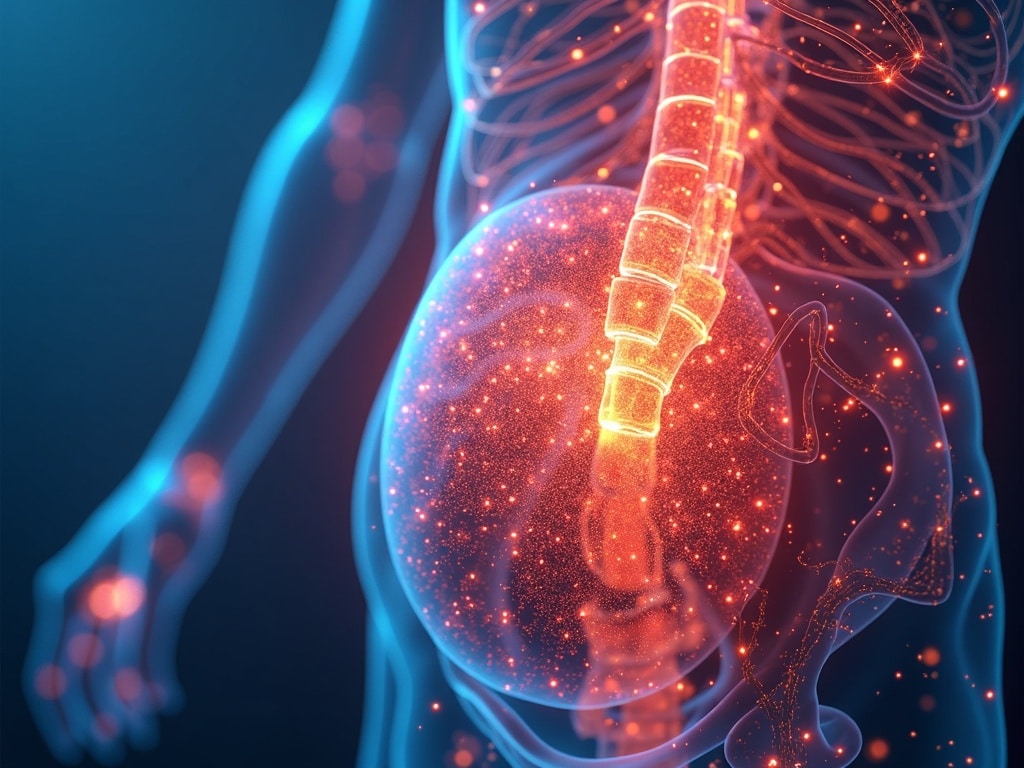Connective Tissue Recovery After Pregnancy: A Comprehensive Guide
Imagine your body as a meticulously woven tapestry. Pregnancy, while a beautiful process, stretches and strains this tapestry, particularly the intricate network of connective tissues. Understanding how to nurture and restore these tissues is crucial for postpartum well-being and long-term health. Let's delve into the world of connective tissue recovery after pregnancy, exploring effective strategies and dispelling common myths.
What is Connective Tissue and Why Does it Matter After Pregnancy?
Connective tissue, as the name suggests, connects, supports, and separates different tissues and organs in the body. It's the scaffolding that holds us together, composed of cells, fibers, and a gel-like ground substance. Key types include:
- Collagen: Provides strength and structure.
- Elastin: Allows tissues to stretch and recoil.
- Reticular fibers: Form a supportive network.
During pregnancy, hormonal changes, particularly the surge in relaxin, soften connective tissues to accommodate the growing fetus and prepare the body for childbirth. This softening, while essential, can lead to:
- Joint instability: Increased risk of sprains and strains.
- Pelvic floor dysfunction: Contributing to incontinence and prolapse.
- Diastasis recti: Separation of the abdominal muscles.
- Changes in posture: Leading to back pain and discomfort.
Therefore, focusing on connective tissue recovery postpartum is vital for restoring stability, function, and overall comfort. Failing to address these issues can lead to chronic pain and long-term complications.
The Role of Hormones: Relaxin and Beyond
Relaxin, the hormone responsible for loosening ligaments and joints during pregnancy, remains elevated for a period after childbirth, especially in breastfeeding mothers. While convenient, this extended flexibility contributes to postpartum instability.
However, relaxin isn't the only hormonal player. Estrogen and progesterone levels also fluctuate significantly after delivery, impacting tissue hydration and collagen synthesis. These hormonal shifts underscore the importance of a holistic recovery approach that considers the interplay of various physiological factors.
Nutrition for Connective Tissue Repair
Fueling your body with the right nutrients is paramount for rebuilding and strengthening connective tissues. Here are some key nutrients to focus on:
Collagen-Boosting Foods
Collagen, the primary building block of connective tissue, can be supported through diet. While directly consuming collagen doesn't guarantee its immediate incorporation into tissues, providing the necessary building blocks is crucial.
- Protein: Essential for collagen synthesis. Aim for lean sources like chicken, fish, beans, and lentils.
- Vitamin C: A crucial cofactor for collagen production. Citrus fruits, berries, and leafy greens are excellent sources.
- Proline: Found in egg whites, dairy, cabbage, and asparagus.
- Glycine: Abundant in bone broth, gelatin, and some protein-rich foods.
- Copper: Supports collagen maturation. Found in nuts, seeds, and shellfish.
Hydration
Adequate hydration is crucial for maintaining the elasticity and integrity of connective tissues. Water helps transport nutrients and lubricates joints, facilitating optimal tissue function. Aim for at least eight glasses of water per day, adjusting for activity level and climate.
Anti-Inflammatory Foods
Chronic inflammation can hinder tissue repair. Incorporate anti-inflammatory foods into your diet:
- Omega-3 fatty acids: Found in fatty fish, flaxseeds, and walnuts.
- Turmeric: Contains curcumin, a potent anti-inflammatory compound.
- Ginger: Another natural anti-inflammatory agent.
- Colorful fruits and vegetables: Rich in antioxidants.
Targeted Exercises for Connective Tissue Recovery
While rest is essential in the initial postpartum period, targeted exercises are crucial for restoring strength, stability, and function to connective tissues.
Pelvic Floor Exercises (Kegels)
Strengthening the pelvic floor muscles is paramount for preventing and treating incontinence and prolapse.
- Proper technique: Focus on contracting the muscles as if you're stopping the flow of urine, but avoid doing this while actually urinating.
- Consistency is key: Aim for several sets of Kegels throughout the day.
- Variety: Incorporate both quick contractions and sustained holds.
Core Strengthening Exercises
Addressing diastasis recti and restoring core stability is crucial for supporting the spine and improving posture.
- Transverse abdominis activation: Gently draw your navel towards your spine, engaging the deep abdominal muscles.
- Heel slides: Lie on your back with knees bent and feet flat on the floor. Slowly slide one heel away from your body, keeping your core engaged.
- Pelvic tilts: Gently rock your pelvis forward and backward, engaging your abdominal muscles.
Avoid traditional crunches and sit-ups in the early postpartum period, as these can exacerbate diastasis recti.
Postural Exercises
Pregnancy often leads to postural changes that can strain connective tissues.
- Chin tucks: Gently draw your chin towards your chest, lengthening the back of your neck.
- Shoulder blade squeezes: Squeeze your shoulder blades together, opening up your chest.
- Wall slides: Stand with your back against a wall, arms raised in a W position. Slide your arms up and down the wall, maintaining contact with your back and arms.
Low-Impact Cardio
Gentle cardiovascular exercise can improve circulation and promote tissue healing. Walking, swimming, and cycling are excellent options.

The Importance of Professional Guidance
While many resources offer general advice on postpartum recovery, seeking guidance from qualified healthcare professionals is invaluable.
Physical Therapists
A physical therapist specializing in pelvic floor rehabilitation can assess your specific needs and develop a personalized exercise program. The therapist will also be able to use therapies such as ultrasound and electrical stimulation.
Chiropractors
Chiropractors experienced in working with postpartum women can address spinal misalignments and restore proper biomechanics.
Registered Dietitians
A registered dietitian can help you optimize your diet to support connective tissue repair and overall health.
Addressing Common Postpartum Connective Tissue Issues
Let's address some specific challenges related to connective tissue recovery after pregnancy.
Diastasis Recti
Diastasis recti, the separation of the abdominal muscles, is a common condition after pregnancy. While it often resolves on its own, targeted exercises and proper core engagement are essential.
- Assessment: Check for diastasis recti by lying on your back with knees bent and feet flat on the floor. Gently press your fingers into your abdomen above and below your belly button. If you feel a gap of more than two finger-widths, you likely have diastasis recti.
- Exercises: Focus on transverse abdominis activation and exercises that strengthen the deep core muscles.
- Splinting: In some cases, a splint or wrap may be recommended to support the abdominal muscles.
Pelvic Floor Dysfunction
Pelvic floor dysfunction can manifest as urinary incontinence, fecal incontinence, pelvic organ prolapse, and pelvic pain.
- Kegel exercises: The cornerstone of pelvic floor strengthening.
- Biofeedback: Can help you learn to properly contract and relax your pelvic floor muscles.
- Pessaries: A supportive device that can be inserted into the vagina to support the pelvic organs.
Joint Pain and Instability
Hormonal changes and postural adaptations during pregnancy can contribute to joint pain and instability.
- Supportive devices: Braces or supports can provide stability to affected joints.
- Strengthening exercises: Focus on strengthening the muscles surrounding the affected joints.
- Proper body mechanics: Pay attention to your posture and lifting techniques to minimize strain on your joints.
Lifestyle Adjustments for Optimal Recovery
Beyond nutrition and exercise, certain lifestyle adjustments can significantly impact connective tissue recovery.
Prioritize Sleep
Sleep deprivation is common in the postpartum period, but prioritizing sleep is crucial for tissue repair and overall well-being. Aim for at least seven to eight hours of sleep per night, even if it means napping during the day.
Manage Stress
Chronic stress can hinder tissue healing. Find healthy ways to manage stress, such as yoga, meditation, or spending time in nature.
Avoid Overexertion
Listen to your body and avoid overexerting yourself, especially in the early postpartum period. Gradually increase your activity level as your body recovers.
Debunking Myths About Connective Tissue Recovery
Let's dispel some common misconceptions about connective tissue recovery after pregnancy.
- Myth: Diastasis recti is permanent. Reality: With proper exercise and management, diastasis recti can often be significantly improved, if not fully resolved.
- Myth: Kegel exercises are all you need for pelvic floor recovery. Reality: While Kegels are important, a comprehensive approach that includes addressing postural imbalances and core weakness is often necessary.
- Myth: You should wait six weeks postpartum before starting any exercise. Reality: Gentle exercises, such as pelvic floor contractions and diaphragmatic breathing, can be started soon after delivery, as tolerated.
The Long-Term Benefits of Prioritizing Connective Tissue Health
Investing in connective tissue recovery after pregnancy yields long-term benefits that extend far beyond the postpartum period. Improved core strength, pelvic floor function, and joint stability can enhance overall physical function, reduce the risk of future injuries, and improve quality of life. It's an investment in your long-term health and well-being, allowing you to confidently embrace motherhood and all its physical demands. Moreover, it sets a positive example for your children, demonstrating the importance of prioritizing health and self-care.

